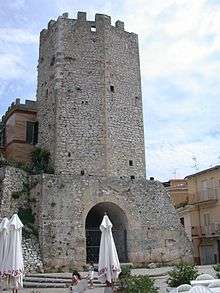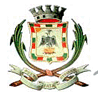Formia
Formia is a city and comune in the province of Latina, on the Mediterranean coast of Lazio (Italy). It is located halfway between Rome and Naples, and lies on the Roman-era Appian Way. It has a population of 38,095.[1]
History

Formia was founded in ancient times by the Laconi and named in Greek, Ὁρμίαι (hormiai, meaning "landing place") and later in early Latin, Ormiae. In the Roman Republic era it was called Formiae (derived from Hormia or Ormiai, for its excellent landing). It was a renowned resort during the imperial era.
Cicero was assassinated on the Appian Way outside the town in 43 BC, and his tomb remains a minor tourist destination. The city was also the seat of St. Erasmus's martyrdom, by being disemboweled around 303 AD, during the persecutions of Diocletian. St. Erasmus later also became known as Saint Elmo the patron saint of sailors.
After the fall of the Western Roman Empire, the city was sacked by barbarians and the population moved to two distinct burghs on the nearby hill, which were under the rule of Gaeta. Charles II of Anjou built a fortress in the maritime burgh, Mola di Gaeta. The other burgh was known as Castellone, from the castle erected there in the mid-14th century by Onorato I Caetani, count of Fondi.
The two villages were united again in 1863 under the name of Formia. The reunited city was badly damaged in 1943–44 in bombing operations and the Battle of Anzio.[2]
Geography
Formia lies on the Tyrrhenian Sea, in southern Lazio, close to the town of Gaeta and next to the borders of Campania region.
The municipality borders with Esperia (FR), Gaeta, Itri, Minturno and Spigno Saturnia.[3] It counts the hamlets (frazioni) of Castellonorato, Gianola-Santo Janni, Marànola, Penitro and Trivio.
Main sights
The most famous monument of Formia is the mausoleum traditionally identified with the Tomb of Cicero: it is a 24-metre-high (79 ft) tower on the old Appian Way, enclosed in a large, 83-by-68-metre (272 by 223 ft) funerary precinct.
Other sights include:
- Tower of Mola
- Tower of Castellone
- Roman cistern, one of the world's largest. Similar to the structures in Constantinople and in the Domitian's villa of Albano, it dates from the 1st century BC.
- Remains of the Villa of Mamurra, partly destroyed in 1943, and of Roman aqueducts and cryptoportici.
- Church of San Giovanni Battista e Lorenzo, known from 841. It was almost entirely destroyed during World War II. It houses a panel by Antoniazzo Romano (c. 1490)
- Church of "San Michele"
- Church of San Luca, known from the 15th century. It has a recently discovered crypt with frescoes of Episodes of the New Testament and Madonna del Latte.
- Renaissance monastery and church of Sant'Erasmo. It was erected on the alleged site of the saint's martyrdom.
- Archaeological Museum.
- Regional Park of Gianola and Mount of Scauri.
Sport
Formia is the seat of the National Athletics School of the Italian National Olympic Committee, founded in 1955. Athletes such as Pietro Mennea and Giuseppe Gibilisco trained here.
Transportation
Formia itself is the most important transportation hub of southern Lazio. The Rome–Formia–Naples railway passes through Formia-Gaeta railway station, from which visitors and residents may travel by bus to Gaeta, Minturno, Spigno and other local towns.
Ferries and hydrofoils connect Formia to Ponza, Ischia and Ventotene.
Twin towns





Notable people
- Antonio Sicurezza (Santa Maria Capua Vetere, 25 February 1905 – Formia, 29 August 1979), painter
- Vittorio Foa (Turin, 18 September 1910 – Formia, 20 October 2008), politician
- Remigio Paone (1899–1977), director and theatrical producer
- Alessandra Canale (b. 1963), TV presenter and actress
- Amadeo Bordiga (Ercolano, 13 June 1889 – Formia, 23 July 1970), politician, founder of the Italian Communist Party
See also
References
| Wikisource has the text of the 1911 Encyclopædia Britannica article Formia. |
- ↑ (in Italian) Istat 2017
- ↑ (in Italian) History of Formia
- ↑ 41192 Formia on OpenStreetMap
External links
| Wikimedia Commons has media related to Formia. |
- (in Italian) Formia official website
- Site of the "Tomb of Cicero" in Google Maps
- https://www.instagram.com/


.svg.png)
